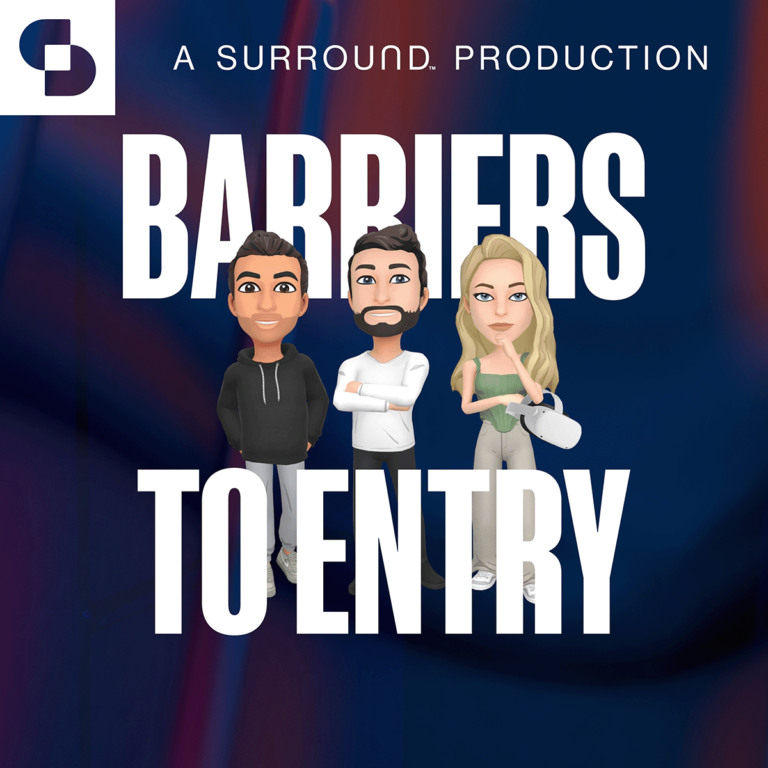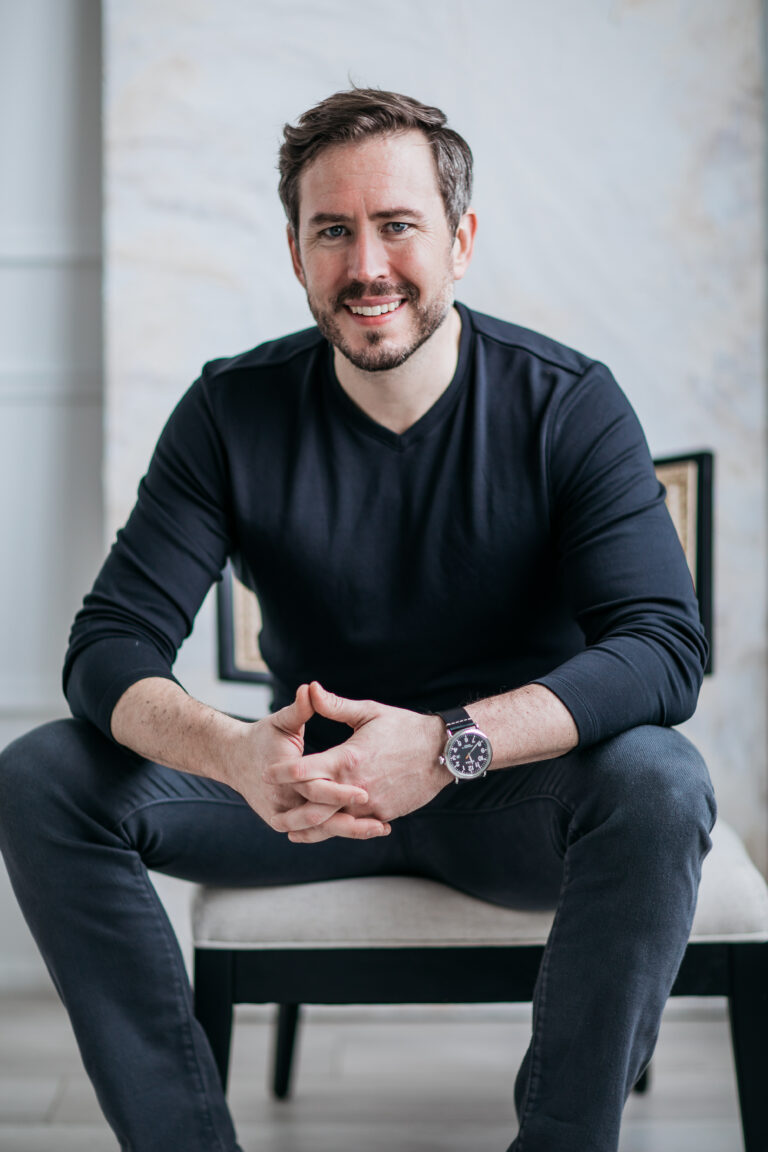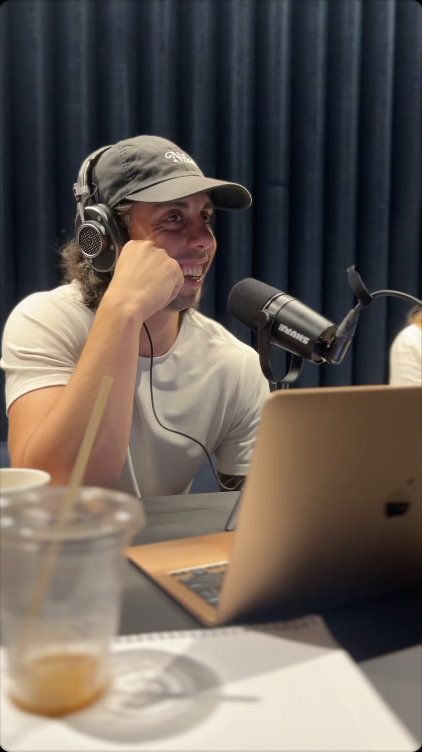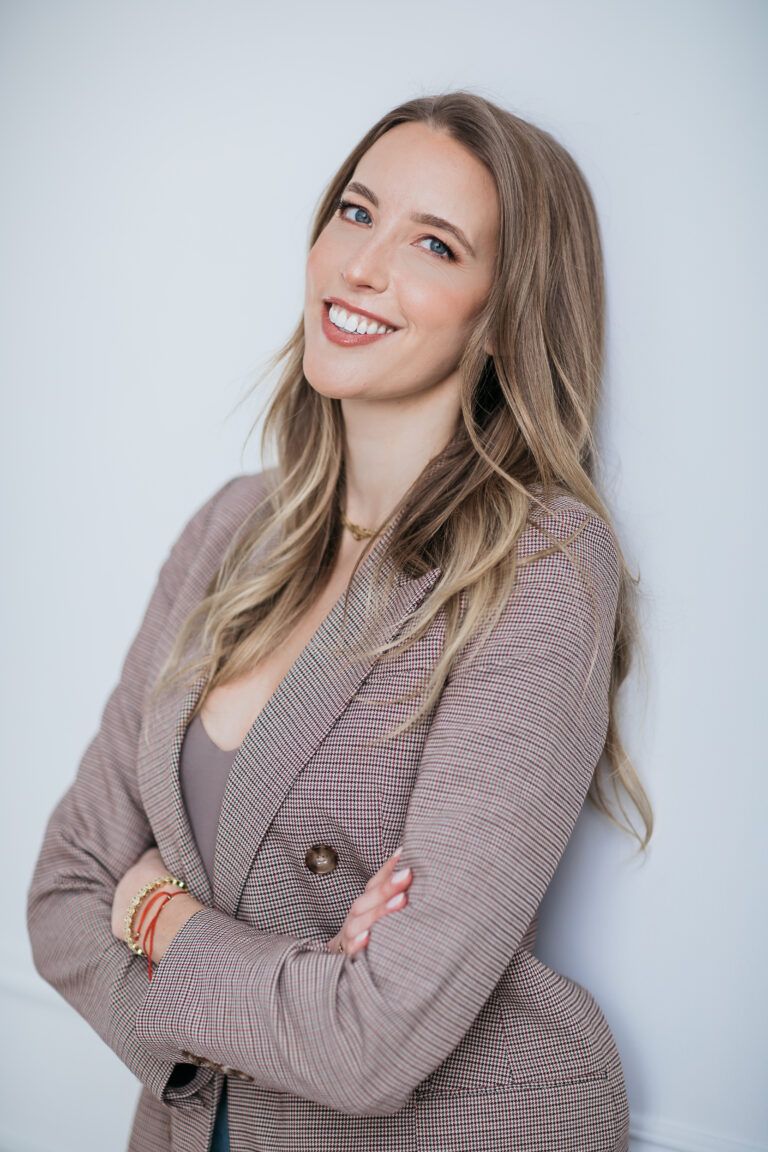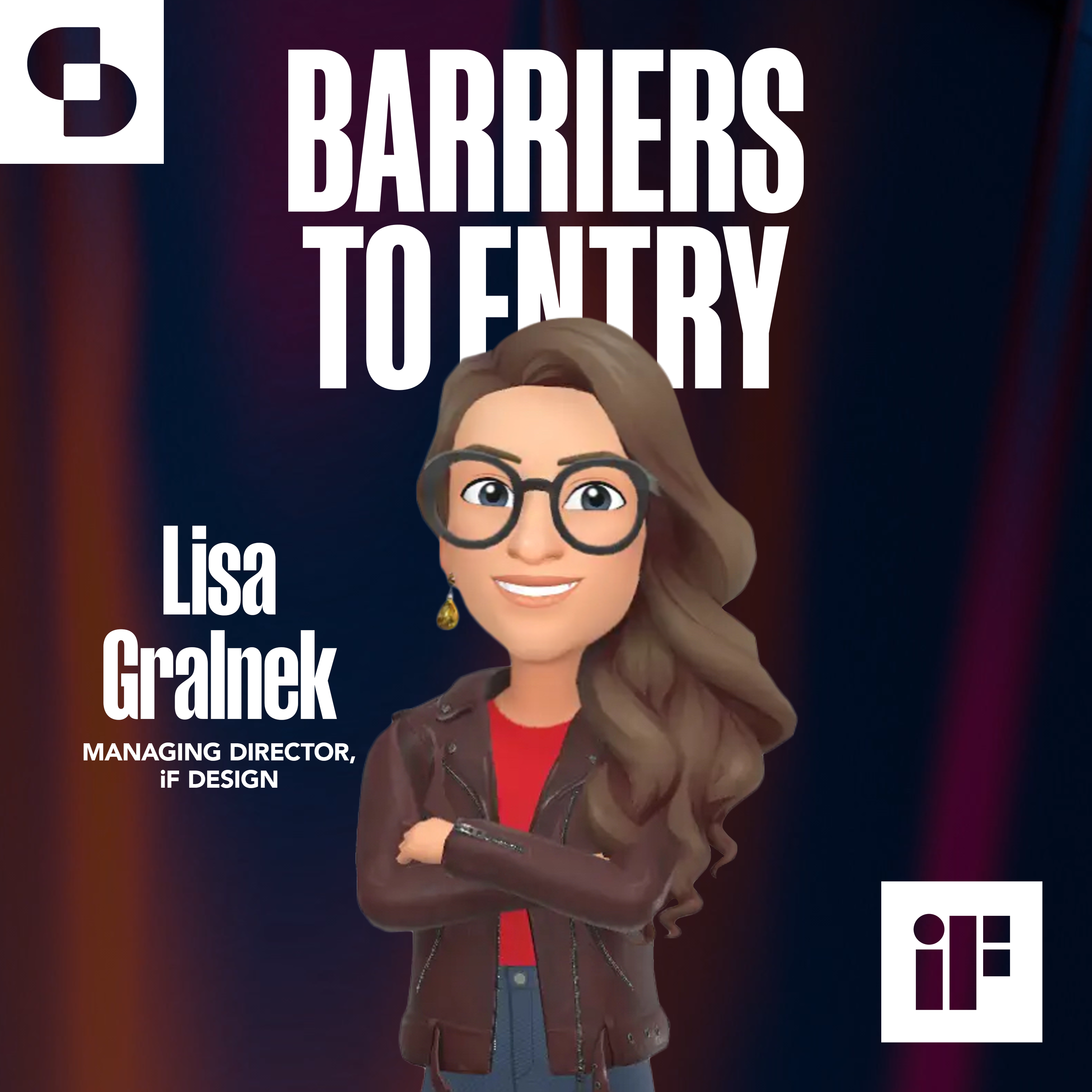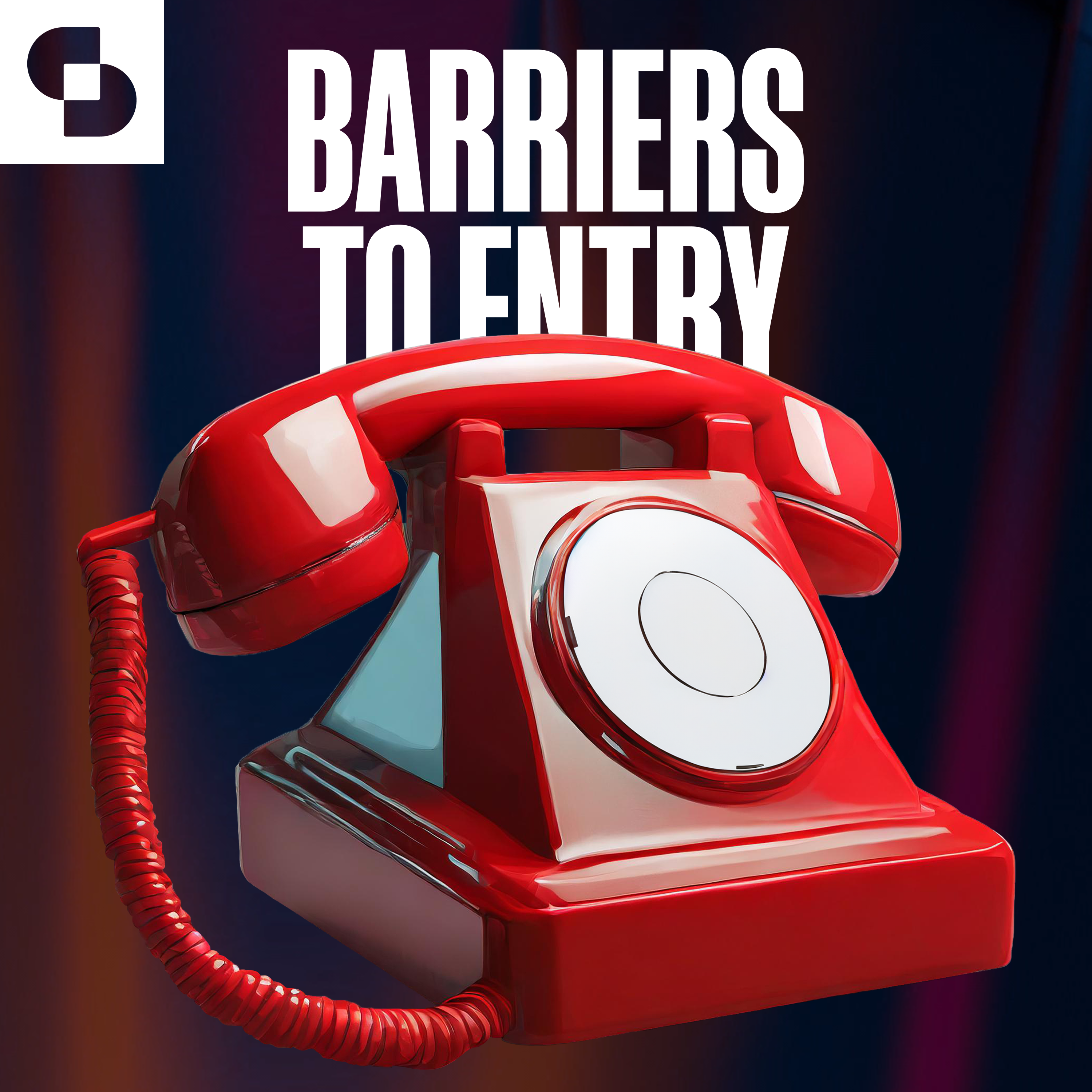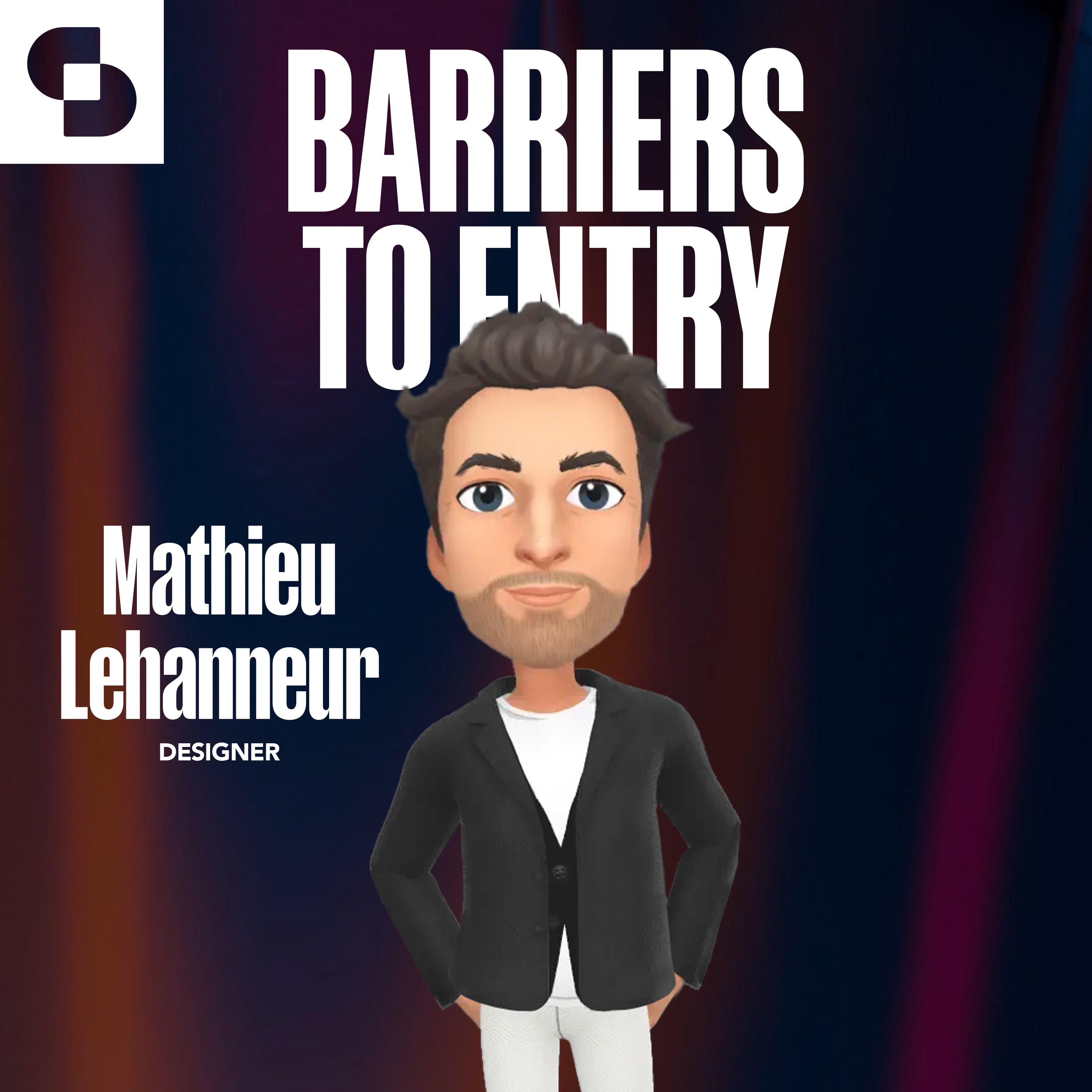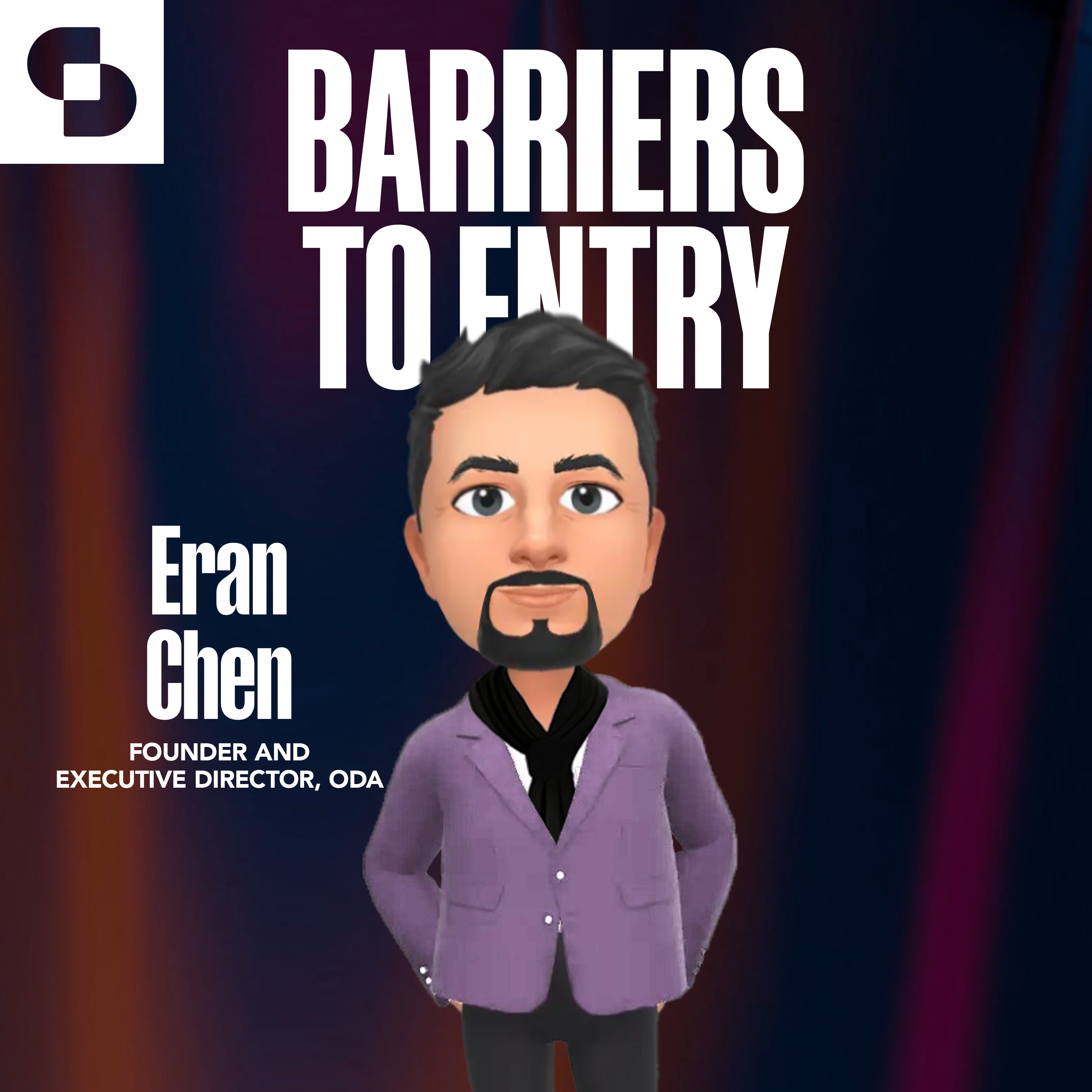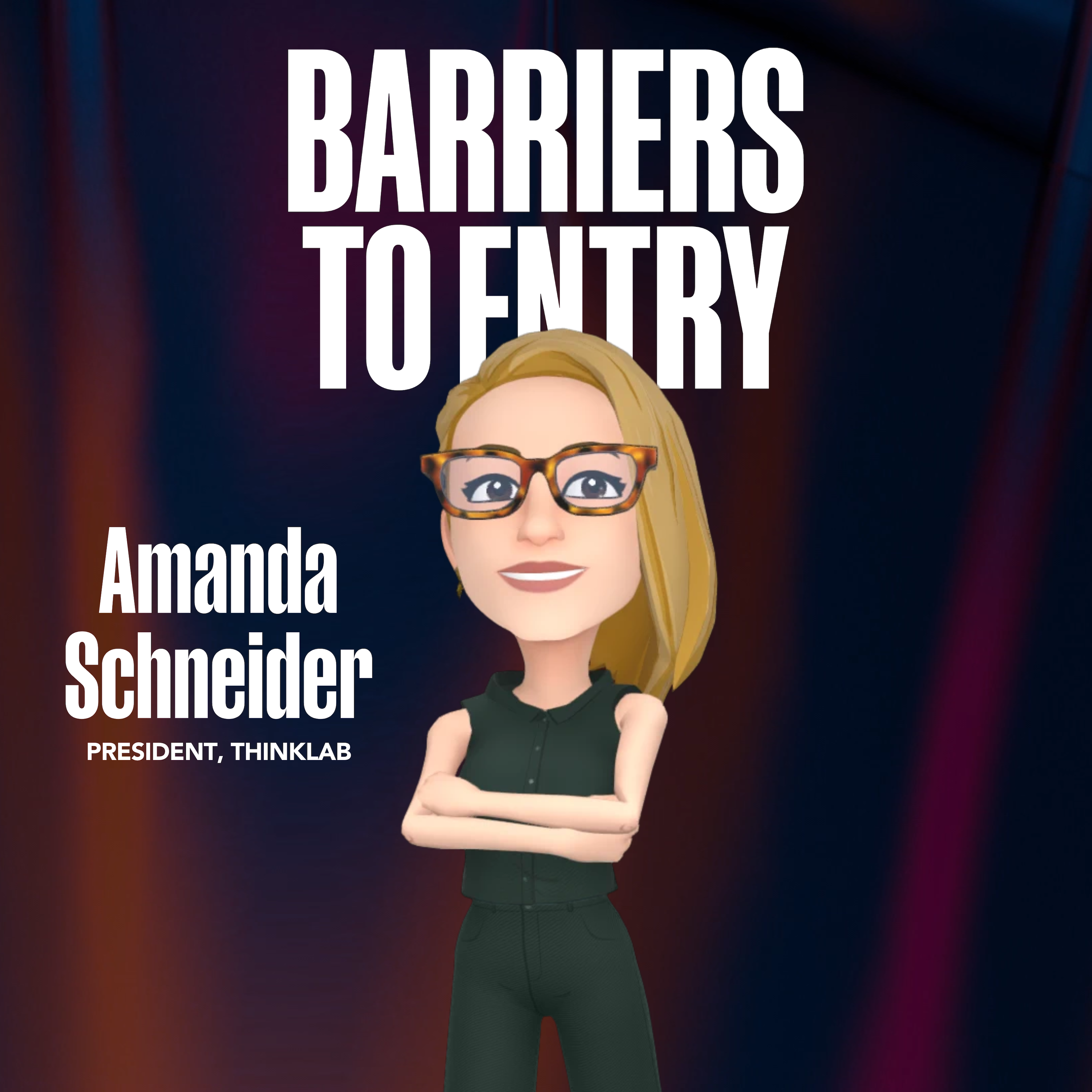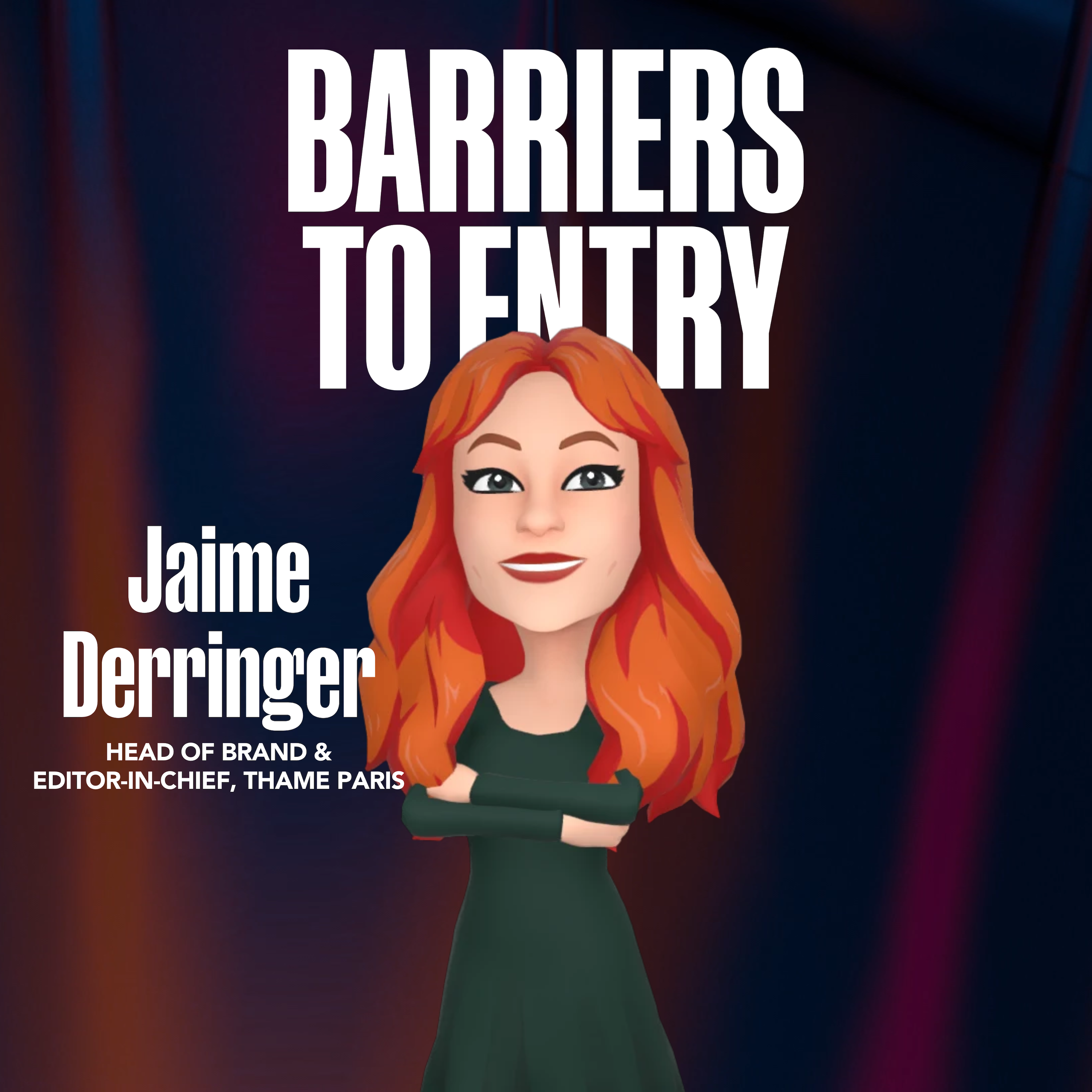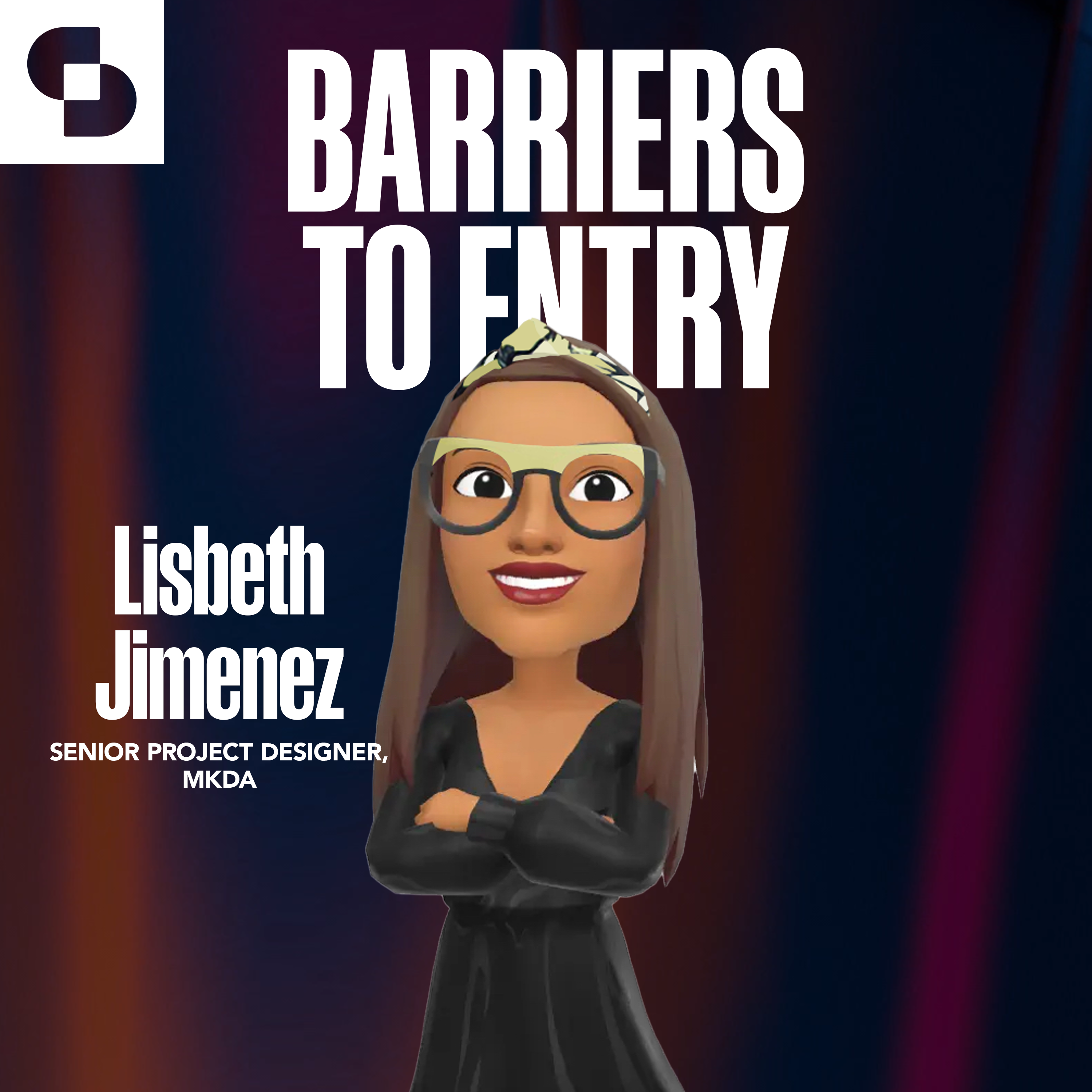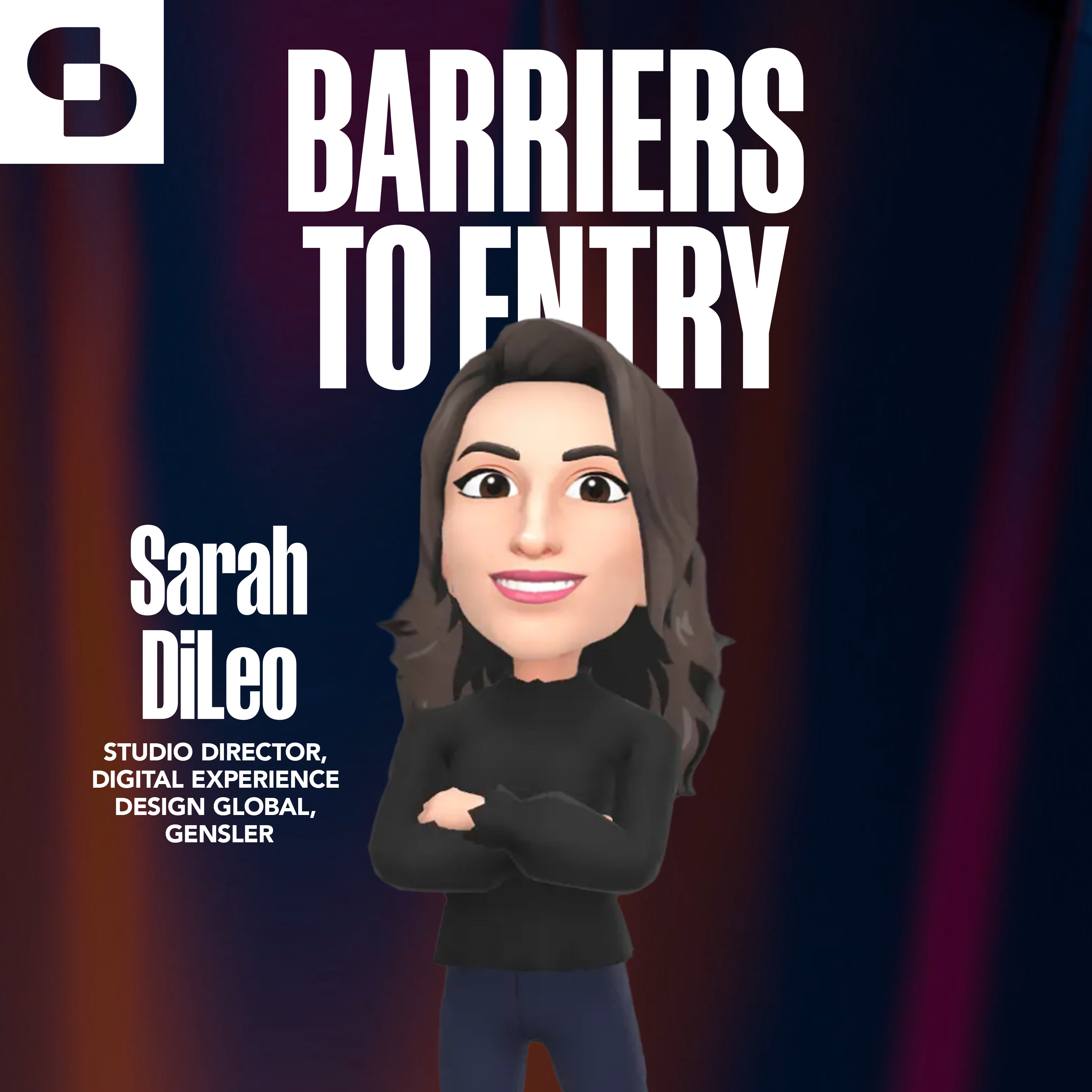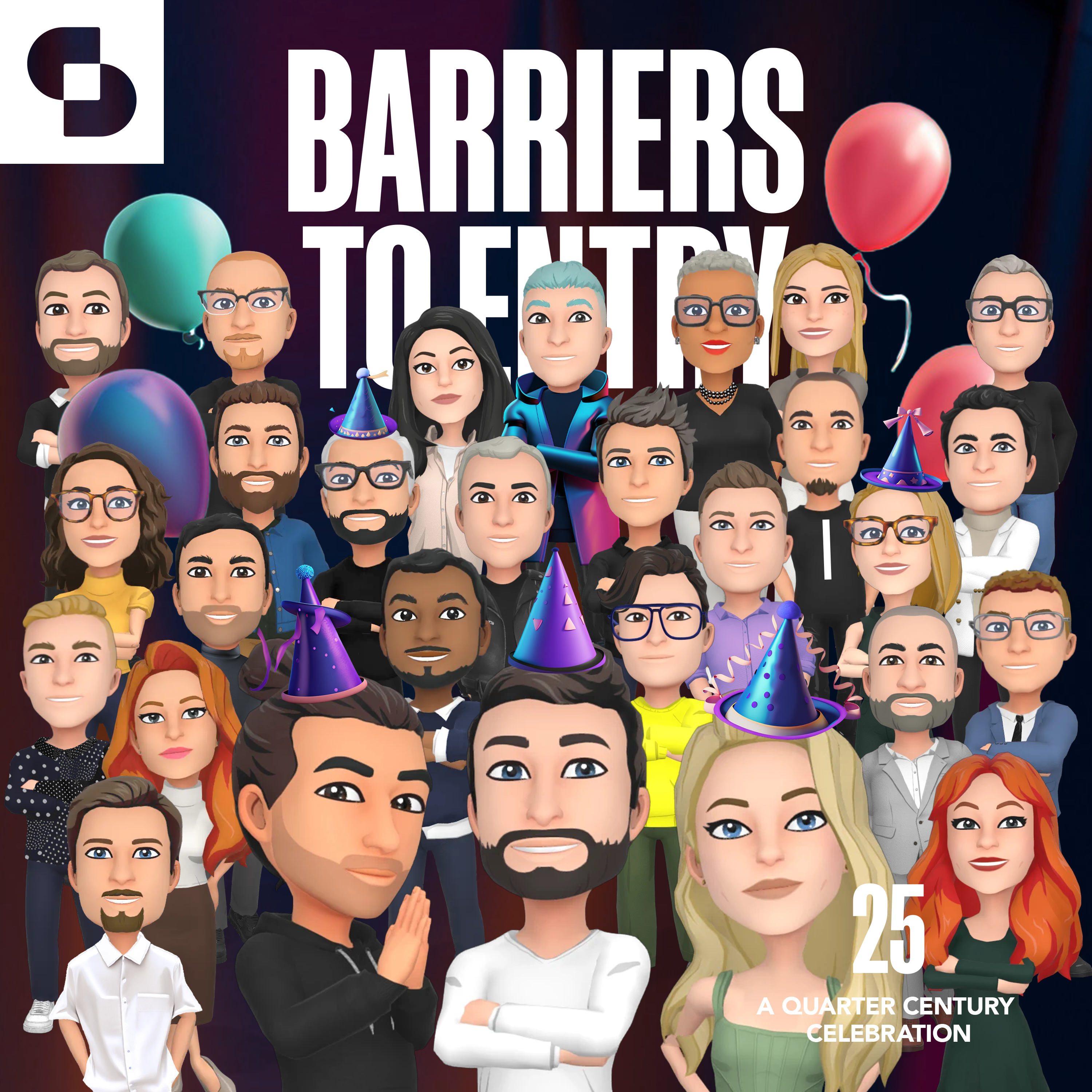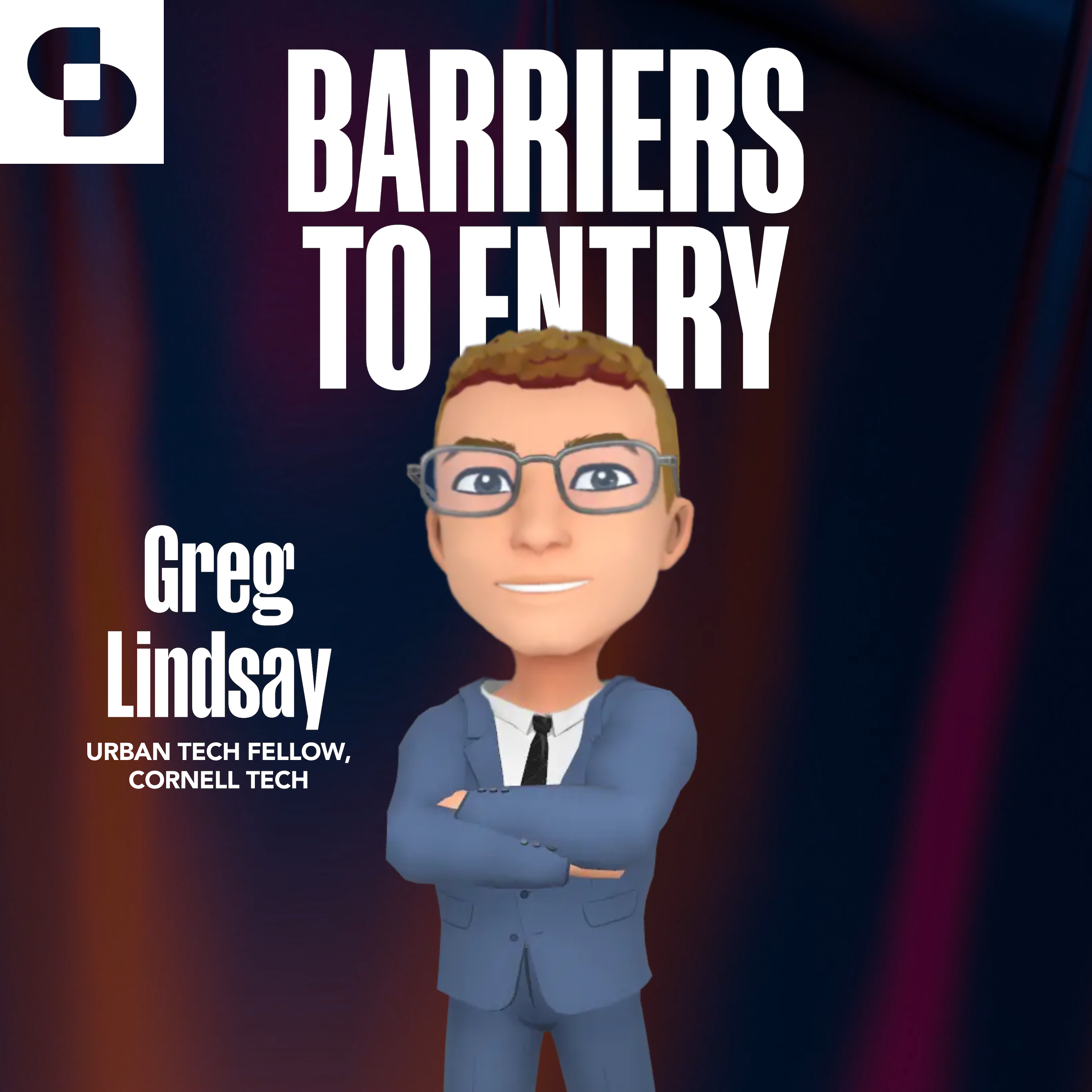On this episode of Barriers to Entry we welcome the Director of Design Technology for Global architecture powerhouse HOK, Mark Cichy! A former professional athlete who grew up architecture and technology obsessed, Mark joins the pod to go deep into what the team at HOK are exploring, peppered with predictions for the future and important calls to action for the industry.
Connect with Mark Cichy on LinkedIn!
Moments to check out:
– Exploring technology to make a difference through design (starts at 10:24)
– Sustainable design and the impact of tech on the future of work (starts at 23:00)
– Deep diving into Digital Twinning (starts at 35:02)
– Thinking differently about attracting talent for a hybrid world (starts at 42:57)
Connect with our hosts on LinkedIn;
References and resources:
- Unity: https://unity.com/
- Unreal Engine: https://www.unrealengine.com/en-US/solutions/architecture
- Discord: https://discord.com/
- Python: https://www.python.org/
Discover more shows from SURROUND at surroundpodcasts.com. This episode of Barriers to Entry was produced and edited by SANDOW Design Group. Special thanks to the podcast production team: Hannah Viti, Wize Grazette, Kasey Campbell and Samantha Sager.
Transcripts, show notes, and links for each episode of Barriers to Entry can be found at surroundpodcasts.com/barriers-to-entry
00;00;03;04 – 00;00;24;02
Mark Cichy
Very rarely does it make sense to create something that only exists as its own microcosm, which I think is true of anything. And essentially that’s how fads are born. Something that exists for the sole purpose of one thing is cool and then not cool 10 seconds later. Our challenge is to not do that.
00;00;24;15 – 00;00;51;27
Bobby Bonett
Good morning. Good afternoon. Good evening and hello to all of our listeners. This is Bobby Bonett, one of our three hosts for Barriers to Entry, the podcast that explores Web3, the blockchain, the Metaverse, digital worlds, digital collectibles, and where all of that intersects with the architecture and design industry. I am seated here today with my two well-mannered co-hosts, Andrew Lane and Tessa Bain from Digby.
00;00;51;28 – 00;00;52;20
Bobby Bonett
How are you all doing?
00;00;53;10 – 00;00;57;16
Andrew Lane
I’m doing great, and I’m always happy to be called well-mannered. I don’t know if Tessa, I was.
00;00;57;16 – 00;01;00;09
Tessa Bain
Going to say I’m not sure if that applies to 100% of us.
00;01;00;28 – 00;01;20;04
Bobby Bonett
So today, Tess, we have an exciting interview lined up with a technologist, amongst many other things, and a former professional athlete from HOK, Mark Cichy, and I know you and Andrew are extremely excited about the opportunity to talk with Mark about everything he’s doing and everything that HOK is working on in this space.
00;01;20;24 – 00;01;39;22
Tessa Bain
Yeah, I think it’s incredible because, you know, for one of the first times and hopefully not the last time we had the opportunity to speak with a guest that actually is using this technology in his every day work life. So we had the opportunity to get really practical with him and hear a little bit about the types of projects that he’s actually applying this technology to.
00;01;40;01 – 00;01;46;21
Tessa Bain
And since he is essentially an expert in a lot of these practices, it was really interesting to hear what he thinks the future will bring.
00;01;46;25 – 00;01;59;15
Andrew Lane
The other thing that was exciting was the opportunity to bring a third Canadian onto the podcast and really give you a little bit of education about your neighbors to the north Bobby, I think that that was just a nice side benefit of our great conversation with Mark.
00;01;59;23 – 00;02;06;11
Bobby Bonett
Yeah, I felt like I was in social studies again. It was exciting. So let’s head over to the interview and here at Mark has to share with all of us.
00;02;08;21 – 00;02;30;21
Andrew Lane
Today on the pod we could not be more thrilled to welcome a technological renaissance man. He is responsible for a team that’s pushing our industry in bold new directions by making big bets on technology to fuel the design process. He’s here today to share some of the thinking behind it. And of course, as much of that special sauce as we can get out of him, please welcome the Director of Design technology for Global architecture powerhouse HOK.
00;02;30;29 – 00;02;33;08
Andrew Lane
Welcome, Mark.
00;02;33;24 – 00;02;35;11
Mark Cichy
Hi, guys. Thanks. Very glad to be here.
00;02;35;28 – 00;02;48;19
Andrew Lane
Yeah, happy to have you. And to kick things off before you made your way into the industry. Being a good Canadian boy like myself, we know that you spent some time playing pro hockey. What were some of the lessons that you learned from that experience that you’re carrying forward still today?
00;02;49;11 – 00;03;10;13
Mark Cichy
In a word, teamwork. Knowing when and how to trust in others, actually, I guess, is one thing that I’ve found that I learned at a young age. Playing hockey is that you can’t do everything yourself right. The teams that inherently know where others are without having to think about it, those are the ones that excel the most. And that’s one of the things that I picked up from playing hockey for so many years.
00;03;10;28 – 00;03;30;07
Mark Cichy
The other thing that I learned from that whole scenario was when to commit and go all in on something, right? So developing good intuition and kind of like a sixth sense for when is a good time to actually push, when is a good time to step back and think about things before you make a move. Those are life lessons, I guess you could say you could get from anywhere.
00;03;30;07 – 00;03;47;24
Mark Cichy
They’re just things that seem to pop up more so in my mind when I look back on my sporting career. But one of the other thing that kind of stands out is knowing when to be introspective, how to be introspective, and when you think you’re like, down and you don’t have any more options, how to collect your thoughts.
00;03;47;24 – 00;04;06;15
Mark Cichy
Step back again and take a bigger look at the larger picture and really dig deep. And I guess in that case, pull out the win, right? So if you’re looking at quite a mountain to climb or something that seems anxiety inducing, how do you step back and just take a moment and say, what am I actually trying to do here?
00;04;06;15 – 00;04;23;14
Mark Cichy
It was break it down into many tiny, smaller pieces and approach it like that. And above all, I guess at the end of the day was just like how to lead, right? How to be a good leader. And I think that just comes with trusting in people. Like comes back to the first point, which is teamwork. It’s not about creating a domain of authority.
00;04;23;14 – 00;04;44;06
Mark Cichy
It’s actually about the complete opposite. It’s not by mandating, it’s by doing and having other people see and follow. It’s by supporting people that are better than you always looking actually, for people that are better than you to fill the gaps, to build a more cohesive unit. So that’s what I got from that.
00;04;44;28 – 00;05;01;05
Tessa Bain
It’s cool. I think like a lot of people when they look at this space, specifically in a lot of our audience members do feel a lot of anxiety or might be intimidated. So I really think that we can relate that to our conversation we’re going to have today. But we want to know where did you go from all of those wonderful things and all that you learn from sport?
00;05;01;06 – 00;05;05;29
Tessa Bain
Like how did that take you to your current position at HOK? Today.
00;05;05;29 – 00;05;26;28
Mark Cichy
So it’s a really long story arc. Obviously sport was part of it, but if I actually think about before even sport and when I was like a child because it goes that far back, is that, you know, I think about my upbringing. We always had technology in the house. My dad was actually a human resources professional, but went to school for electrical engineering.
00;05;26;29 – 00;05;54;02
Mark Cichy
You know, it was like one of those scenarios. We had workshops upon workshops that you see in movies or like the latest Ghostbusters movie that my five year old loves, where there’s a whole workshop of trinkets and gadgets and little like ‘thing-a-muh-bobs’ that are like circuit boards and resistors. I learned to solder at like seven or eight years olds almost burned my finger off because I was trying to mess around with different circuit boards to be able to modify devices.
00;05;54;02 – 00;06;00;18
Mark Cichy
I think one of the first ones I actually successfully modified was my PS One to put a mod chip on it so I could play any game I wanted.
00;06;01;04 – 00;06;03;02
Andrew Lane
But the skip levels and.
00;06;03;19 – 00;06;08;26
Mark Cichy
Above were also, of course, like before that you have the NES, and the genie, whatever they were the game genie, right?
00;06;08;29 – 00;06;09;08
Andrew Lane
Genie.
00;06;09;08 – 00;06;24;27
Mark Cichy
Oh yeah, all that was done for you. But this was like another level of that. But I just always had an innate interest in understanding the inner workings of things. My family had a computer, a real young age, I think I was 6. My dad would bring home these floppy disks from work. He worked for a major North American auto company.
00;06;24;27 – 00;06;36;00
Mark Cichy
I won’t name the name because it’s not exactly legal to be taking the software home, but this was before we had like licensing managers and stuff. It’s just literally you had possession of the disk and you could install the software.
00;06;36;01 – 00;06;40;23
Andrew Lane
We have all of our listeners sign an NDA before they listen to the podcast, so don’t worry about this.
00;06;40;26 – 00;06;58;07
Mark Cichy
So, you know, he brings home these disks. I look at these things, I don’t know what they are. They got a sticker literally like somebody printed off on a dot matrix printer. That’s how they used to distribute software, right? And one of them was three studio. This was like in the late eighties. And some people who listen to this may not even know what DOS is, but you had to like insert each disk by disk.
00;06;58;07 – 00;07;19;17
Mark Cichy
It said insert this to this three. There are like 27 disks. So I’m sitting there with very primitive 3D modeling software back in like the mid to late eighties, messing around eight years old. And I just always had an affinity for these things. So years later that I would, you know, be in high school and I had my first Pentium, which was a big deal at the time, and I would just experiment with this stuff.
00;07;19;17 – 00;07;50;09
Mark Cichy
So this is simultaneously as playing hockey. I had this kind of like duality mindset, but I was obsessed over the arts specifically, like fine arts, right? So like the abstract Expressionists from the forties through the sixties, the Pollocks, Picasso, Kandinsky, there was a playfulness and a complete abandonment of like a systematic organization. It was just all about emotion and feeling in the representation of raw feeling, which was, I guess, the hockey aspect, right?
00;07;50;09 – 00;08;14;07
Mark Cichy
And then there was this systematic aspect, which was the technological application and derivative of modeling things like cubes or things that had set dimensions. The two things together, I thought, how can you combine these things? So that one is the expression of the other. And that whole time I just spent most of my teenage years trying to hold my hand, my drawing skills and doing graphic novels.
00;08;14;10 – 00;08;30;21
Mark Cichy
They felt like they were like a release to explore narratives. At the time, what I knew, like I didn’t know architecture, so I was like, What can I write about? Not right. I can draw about a story because I love to draw stories, and I guess that’s where I find myself today is being a storyteller in a sense.
00;08;30;21 – 00;08;49;13
Mark Cichy
But I use technology as a vehicle. I mean, I was really lucky through my post-secondary education to go to a fantastic school, one that’s arguably one of the best in the world for computer science. You know, while I was there for architecture, I had access to some of the smartest and most brilliant people in computer science at the time.
00;08;49;18 – 00;09;15;04
Mark Cichy
This was like in the late nineties, early 2000, when I taught myself how to code. So there was a resource I could access. Like I had no idea. So I took one course in computer science. I had 36 hours of class a week for architecture, a quickly realized like flunking out of computer science courses that it just wasn’t going to happen to do a dual degree scenario and that, to be honest, it was hard to fail at something having succeeded professionally in hockey and never really tripping over myself.
00;09;15;04 – 00;09;42;26
Mark Cichy
But it taught me that you can do that you don’t necessarily need to achieve it through academia. It’s like the principles of it you can still teach yourself. So I’d spent every waking second I had outside of delivering my coursework, teaching myself how to code. I was really lucky because at the same time, environmentally within the profession, architects like Bernard Shumate, Peter Eisenman, Greg Lin or Goldthorpe, these were people that were young ish, maybe not Peter Eisenman, but some of the others at the time.
00;09;42;26 – 00;10;01;08
Mark Cichy
And they were just coming to fame and they were using technology as a vehicle to explore art and architecture at the same time. So there was like a cautious optimism. I wasn’t so supported at my school because most of the professors and the institution itself in architecture at the school I went to is still like firmly grounded in like, here’s what we know.
00;10;01;08 – 00;10;22;17
Mark Cichy
Like this is critical theory thinking and thought that is the cornerstone, which it is. I don’t disagree, but they didn’t truly understand how technology could be a contributor to the discourse of spatial and social development. And that was something that took years to figure out. But for the most part, I felt misunderstood. I find it really ironic now that technology permeates almost everything that we do in society.
00;10;22;27 – 00;10;38;04
Mark Cichy
And though I think it’s important that we always ask ourselves why the meaning of something, the application development technology should have a purpose. It should enhance the human experience, not just because we can. So that’s what I always ask myself. Is it making a difference?
00;10;38;19 – 00;10;50;08
Bobby Bonett
So was asking that question why? And thinking about, like you had said, Mark, the enhancement of the human experience, is that sort of what led you into exploring XR and Metaverse solutions as part of your work at age? Okay.
00;10;51;06 – 00;11;21;22
Mark Cichy
Yeah, that’s what actually pairs me. And this genuinely, I don’t say this to just put words in the mouth, but that’s what actually makes HOK. Such a great place for me personally is the fact that there is a sincere belief that, you know, it is about physical space, right? It is about how people exist within that space, what we do to enhance it, how we build it, how we make it, how the thing that we occupy performs, what it gets back to, not just the people within it, but largely in society.
00;11;21;22 – 00;11;49;11
Mark Cichy
And that’s through things like social equity and sustainability. Because, yes, architecture is actually a social exercise, believe it or not, when you think about it, the idea that when we explore the technology, we’re looking at how we can innovate and be leaders, but in ways that allow the technology to enhance and fulfill those objectives in a social environmental responsibility design, what is good design, right?
00;11;49;13 – 00;12;09;27
Mark Cichy
So that means on the front end, like how you can use it to explore design. But it also means now what happens when things leave Just the digital space and the digital aspect becomes part of that physical reality. And so that’s what we’re interested in exploring and what our research and our efforts so far today represent in the realm of the maps.
00;12;10;09 – 00;12;28;15
Tessa Bain
And I think that’s really fascinating because a lot of our listeners are probably wondering, how does this work practically? How do all of these technology advances actually implicate your day to day life? And you’ve got a lot of experience where you’ve shared with us that they do. We know that a lot of your work is under NDA, so we’re not going to ask you to share with us client names.
00;12;28;15 – 00;12;30;21
Tessa Bain
Again, I’m always the nosy one on the podcast.
00;12;30;21 – 00;12;31;06
Andrew Lane
Maybe, maybe a little.
00;12;31;06 – 00;12;40;10
Tessa Bain
So if you want to tell us, I’m not going to say no, no, I’m just I’m joking there. But at a higher level, we’re hoping that you can maybe share more about some of the concepts that you’re exploring.
00;12;40;21 – 00;13;04;24
Mark Cichy
Yeah, clients are working with very we’re in a lot of different industries in markets. We’re in aviation, we’re in sport and entertainment, we’re in workplace and offices. We have clients that are looking to integrate technology, to streamline a connection between the design process and the operational longevity of an asset. Basically a long winded way of saying they want to understand how their buildings operate throughout their lifecycle a lot better.
00;13;04;24 – 00;13;43;09
Mark Cichy
So it’s not just a dead asset or a fixed lifecycle that needs to be torn down and rebuilt to others wanting to explore concerns and strategies over spatial equity and neurodiversity. That’s essentially simulation using digital technologies, game engines to explore different spaces and allow customizations and overlays of, say, a design space or a physical reality. I’m sure I’ll be asked at some point to give my opinion about the future of everything we’re talking about today, but I truly feel that we’re going to get to a stage where the connection between physical and virtual worlds is hardware.
00;13;43;09 – 00;14;03;24
Mark Cichy
It always will be hardware, but at some point it’ll be indistinguishable as to whether or not it exists, right? So the idea is like an invisible layer that connects the two and so what we’re trying right now is we’re at that initial stage is headphones, headsets, right. To be able to look and interact with a space and change it.
00;14;03;24 – 00;14;32;05
Mark Cichy
So that it can accommodate some of those more acute sensitivities that individuals may have in a workplace environment. And then also, I guess the last one is some of our clients are just looking to enhance the live experience of an event. This is when it comes to like sport, like e-sports or Mercedes-Benz Stadium as an example. These are the sorts of things that we’re looking at and studying with our clients to say what can actually heighten experience, how can we engage and provide some additional value.
00;14;32;05 – 00;14;44;04
Mark Cichy
Maybe this season ticket holders, how can you be there or not be there, but still interact with and be part of that event without commoditizing it or turning it into like a strip mall sort of scenario?
00;14;44;15 – 00;14;58;07
Andrew Lane
What are some of the principles, if any, or what is it that you’re thinking about that helps you really stay grounded in the physical because you’ve said that so critical. But as you’re going far field in exploring new technology, what is it that keeps you grounded in that utility? In the physical world?
00;14;58;18 – 00;15;19;28
Mark Cichy
It’s kind of a tough thing. You know what comes to my mind is always like a kind of deep philosophical answer for something like that. If I were to reduce that to like a one line is to say very rarely does it make sense to create something that only exists as its own microcosm, which I think is true of anything.
00;15;20;23 – 00;15;42;04
Mark Cichy
And essentially that’s how fads are born. Something that exists for the sole purpose of one thing is cool and then not cool 10 seconds later. Our challenge is to not do that. We sit down with our clients or internally among ourselves. The first question we ask ourselves is ‘What is the purpose?’ Since back to the what we’ve identified at each, okay, that our purpose is, you know, the physical.
00;15;42;04 – 00;16;00;16
Mark Cichy
I’ll tell you why. From a certain perspective, what we truly believe is this is where architects live, is in the physical realm. We all have a passion for that. There’s an understanding of reality, and some people may think of them as constraints. These are things like gravity, uplift, physics, but they’re also beautiful things. How do you shape light?
00;16;00;24 – 00;16;32;16
Mark Cichy
How do you ventilate it naturally, make spaces comfortable and desirable, right? These are things that you can do there, moves you can make. There are opportunities to take things that are real and make something that heightens an experience. So those are the realistic aspects. So our question to ourselves is how do we enhance that and create a deeper bond and layer of interaction by incorporating digital tools, processes and a meaningful connection that intervenes in some way.
00;16;32;16 – 00;16;40;20
Andrew Lane
When that’s absent, it seems a bit more trinket or gimmicky. How is it that you sort of identify and sniff that out and realize that’s not the path?
00;16;40;20 – 00;17;08;17
Mark Cichy
And sometimes we actually go pretty far down a rabbit hole before we ask ourselves a question. And I think this actually comes back to human nature, partially to be perfectly honest, because I’m probably myself guilty of it, but don’t see it because I’m sometimes blinded by my own pursuit of something that is of interest to me, that veers off the path of the larger goal.
00;17;08;17 – 00;17;30;15
Mark Cichy
And I think we all do that. And that’s some of our research effort, some of our team sometimes. But we find ourselves going down a hole and then when you get a third or fourth paralyzed like a critic, that’s, I think, the beautiful thing about architecture is that where we critique ourselves in a constructive way, we actually create a more solid foundation for our arguments or what it is or strategy, what we’re trying to achieve.
00;17;30;15 – 00;17;55;12
Mark Cichy
But we will often sit there and question ourselves constantly to just say, Look, is this something that has a real place or is it something that is just kind of cool but just has no real meaning? Gimmicky? Yeah, gimmicky, essentially. Yeah. So when we step back and we say, does it actually add value to what it is we’re trying to achieve, but does it actually achieve the goal?
00;17;55;16 – 00;18;14;07
Mark Cichy
The answer, like seven or six times out of ten? No. Then what’s some more constructive way that we can do to achieve that? Another strategy, right? Sometimes that means going down a road that we don’t have the expertise for. And that’s actually the hardest thing to overcome, is how do you achieve something that you don’t have the answer for?
00;18;14;07 – 00;18;20;08
Mark Cichy
And the shortest answer to that is to either acquire the knowledge or to work with people who do it.
00;18;20;08 – 00;18;42;22
Bobby Bonett
Sounds like a lot of what you’re doing is exploring that path where there’s some unknown because the solutions that you shared at a high level, it doesn’t sound like there’s a lot of templatizable, visible design you’re doing on the digital side for your clients. It sounds like clients come to you with a pretty specific challenge, and as an organization, HOK, has to come back with a pretty specific solution.
00;18;42;25 – 00;18;51;11
Bobby Bonett
So how does that weigh on you from a creative ideation standpoint? And how do you stay fresh from an idea generation standpoint when you’re in a constant state of creation?
00;18;51;19 – 00;19;24;17
Mark Cichy
It’s challenging because you could be completely stuck in a circular evolution of design, which I would deem that creative purgatory to be perfectly honest, because there is no end and no beginning. You are just floating in a place of nowhere. So when you think about it fundamentally, at the end of the day, things like physics in reality are actually the answer to grounding and finding a way out of nowhere because there are a set of certifiable objectives that need to be achieved in order to fulfill it.
00;19;24;17 – 00;19;56;20
Mark Cichy
Now, when we come to say really complex scenarios is as a firm HOK, has made our reputation on being the grown ups in the room for lack of a better way of putting it. To to take a really complex, large, difficult problems that are infrastructure scale like aviation or city, like urban scale solutions, and then to come up with adaptable and reasonable and achievable design solutions for those problems.
00;19;56;23 – 00;20;25;19
Mark Cichy
That doesn’t mean that it’s boring. It just means that we are always looking for the best solution that achieves as many objectives within the constraints that are possible. So we try not to say everything at the cost of design or everything in the service of systematic application, like it’s what is the best solution for all of these things that is the most sustainable and well thought out.
00;20;25;29 – 00;20;44;29
Tessa Bain
I want to jump back to utility for a second, because future of work is a really hot topic right now. It’s what everyone seems to be talking about and based on what you were just saying in pulling that thread, do you see utility in a lot of this technology and 3D spatial technology, specifically in applying itself in the future of work?
00;20;45;16 – 00;21;14;27
Mark Cichy
I wanted to answer yes before you could finish the question. So yes, we’ve done this and we do it obviously to satisfy clients. The easiest way to help them understand what it is that you’re proposing is to visually show them what it looks like, the closest representation of your ideas and everything you’ve discussed with your client in a visual manner that they can understand by just looking at it and saying, Of course it is, because that’s reality.
00;21;16;00 – 00;21;40;18
Mark Cichy
So what is better than what appears to be a reality that represents everything you’ve discussed and what they hope for and what their dreams are in a digital form. The extent to which that goes very is we have a client where we left a kiosk on site for them to be able to understand what the reinvention of their workplace would look like at any point in the day.
00;21;40;18 – 00;22;01;19
Mark Cichy
If they just want a break or they want to go see that place, to just put a headset on and walk around, that’s obviously a more advanced use case scenario. Your typical forms of representation like videos, animations, renderings, those things we do those so they become ubiquitous. When I was first starting out in the profession, if you could do stuff like that, it was like, Whoa, man, look at what these guys can do.
00;22;01;19 – 00;22;38;15
Mark Cichy
Is photo realistic? It looks fantastic. Every client wants to know what it is before what it is. And now that just that just happens. A lot of software in the industry have just filled in that gap. Things like inscape game engines to a certain degree, but this is the go between, I say between the true kind of symbiosis of the two realms and of course with some clients specifically, I mean, in the workplace, with the return of the whole RTO return to office scenario, a lot of people are starting to try and bridge that gap to say how can the actual office become, in a way, almost a living thing, like a thing that you
00;22;38;15 – 00;23;01;23
Mark Cichy
interact with? Right? It’s an extension. So computing is now buried everywhere, but it’s seamless and you don’t really see it. It’s just it’s effortless to be able to do it. You walk into a room and things happen because it’s instantly recognizable that Mark has walked into the office. So all of my settings pop up comfort, lighting, equipment, it’s all just done.
00;23;01;23 – 00;23;09;27
Mark Cichy
So you compare and contrast that with the old world of, Oh, you know what, the Internet’s not working or your audio, your mic sounds like a —
00;23;10;12 – 00;23;11;03
Andrew Lane
Yeah, right.
00;23;11;14 – 00;23;26;04
Mark Cichy
Right. And that’s the idea that you should be there without having to worry about anything. A focus is on what you do, not how to get there and overcome the obstructions to get to the point where you need to do what you need to do.
00;23;26;28 – 00;23;42;02
Tessa Bain
What about digital twinning? Where do you see that taking itself into a metaverse application? So we talk about using the technology pre build. What about those interactions post build when you’re talking about the physical space working for you, what about the remote workers? Any perspectives on that?
00;23;42;24 – 00;24;04;08
Mark Cichy
I’m going to make a wild accusation that I truly and be believe within my soul is that anyone that says that they think that they have solved the hybrid integration and into the return to office is lying through their teeth because we’re all trying to figure this out. Number one, I don’t think anyone can say I got the solution.
00;24;04;08 – 00;24;27;08
Mark Cichy
Having said that, I think you’re right. There are two perspectives to look at that. There is the I can plan for up front as part of a process of developing something that will eventually will be right. And then there’s the backend retrospective postmortem. I have something. How can I extract and optimize that thing, leveraging technology to the best of my ability.
00;24;27;18 – 00;24;55;00
Mark Cichy
And obviously we are squarely a foot in both realms because not everybody is retooling and destroying their space and redeveloping anything. So, you know, largely the conversation starts with where are you? What are you willing to do? At what extent are you willing to achieve it? And there are systems that are integrated more specifically into the building, and there are systems that possess a layer on top that just give you insight.
00;24;55;00 – 00;25;29;07
Mark Cichy
Question is what will help you make better decisions as a business strategist and owner? And then focus on those solutions and tools that are available to achieve that need. And that varies widely for us because for some people it’s simply about occupancy allocation and spatial optimization. And for other people it’s about how much convenience can we provide, what are the things that we can automate and achieve to make certain elements of a workday completely effortless?
00;25;29;15 – 00;25;48;29
Mark Cichy
And it varies widely in all areas in between, from silly things like digital lockers and food delivery, all the way from you’re just in a meeting and a robot delivers your skip the dishes to the desk beside you when you’re in the meeting so that you can continue to keep doing what you’re doing too.
00;25;49;00 – 00;26;02;16
Andrew Lane
I really hope we bring back robot butlers. Just as an aside. Well, they were kind of big back in the eighties called actually the beginning of your story. But I’m there with you. Sorry to interrupt, but that’s. No, I don’t have enough We don’t have enough of that in design today.
00;26;02;16 – 00;26;32;01
Mark Cichy
But usually when you think about it before you even get there, there are so many other bigger problems to solve then am I getting a six wheeled miniature robot delivering my lunch to my side sort of scenario like so many other layers? And so what we like to do is we tend to look at the overall. This comes back to the human experience thing, but we personify what an individual workday looks like from the time that they wake up to the time they go to bed.
00;26;32;01 – 00;26;50;00
Mark Cichy
And at every point in between where they touch or interact with an element of their workday, how can that be enhanced in some way, shape or form? Right. By technology, Right. What I mean, the personification of the people who are there, the people who are not there, the people that are there and not there. And what that means.
00;26;50;00 – 00;27;14;11
Mark Cichy
And it can get crazy sometimes you talk about self-driving cars and stuff. It’s a big subject matter that comes up. A lot of vendors, believe it or not, it’s crazy. There are already vendors that are thinking about wireless charging pads for cars that they can put into the concrete pour so that eventually when the cars can just park themselves over that heat pad, essentially the battery just charges because it’s parked in spot, there’s no plug, there’s no nothing.
00;27;14;14 – 00;27;15;23
Mark Cichy
So all kinds of crazy stuff.
00;27;16;04 – 00;27;25;10
Tessa Bain
How often do you encounter people that are designing, working with you on projects that are thinking that far ahead in the future instead of going retroactively and looking at it later.
00;27;26;00 – 00;27;52;27
Mark Cichy
It’s becoming much more common. There was an initial fervor, a whole bunch of retooling, a lot of stuff. I’ll say like nine months later, a lot of heat wore off and people were just like, Whoa, this costs real money. We need to like, slow down. Let’s think about this for a minute. Right? What are because, you know, there’s me, Jiminy Cricket on a lot of people’s, like probably stabbing myself in my foot saying, you know, think about what are your objectives sincerely think about it.
00;27;52;27 – 00;28;08;09
Mark Cichy
You’re going to go public to your staff and say, like all this stuff. And then they’re going to sit there and say, This is fantastic. And they’re going to say, Yeah, we’re going to deliver 20% of this. And then, oh, and then you lose workforce, which is arguably happening anyways, right? But I mean, it’s starting to shift a little bit.
00;28;08;09 – 00;28;49;17
Mark Cichy
So really we come back to just realistically assessing. It’s kind of like being a grown up again, comes back to that. What do you need that need versus the want and the strategizing over a phasing period of 2 to 5, 5 to 10, 10 to 15 seems crazy to think 10 or 15 years out. But the 2 to 5 is crucial because it lets people establish a solid foundation that essentially and what’s really difficult about this and what companies have come to realize and this goes for everybody actually, but what people come to realize is they used to be able to sing on five year trajectories with built assets technology, if you think about it
00;28;49;17 – 00;29;09;03
Mark Cichy
historically, is I’m into a new computer, barely making it to two years, right? Technology is like an annual cycle, Max, maybe 18 months for a lot of stuff. Specifically, a lot of little things are like constantly like you get people who are getting new iPhones every year, which like that’s extremely wasteful. But we can debate that all day long.
00;29;09;15 – 00;29;32;02
Mark Cichy
But there’s a cycle that they have to consider now is unlike anything they’ve ever seen. And that’s the thing that is mostly anxiety inducing, that they have to come to grips with is how do you design on a two year cycle perpetual cycle and not be obsolete, but balance the books and bring everything into harmony? That’s the challenge.
00;29;32;02 – 00;29;45;23
Mark Cichy
And it’s even more prevalent and challenging in infrastructure because these are things that are around for 60, 70 years. How you think about every two years on that scale, it’s insane. So those are some of the challenges we have to grapple with as well.
00;29;45;28 – 00;30;04;11
Andrew Lane
I was curious, you’re talking a pretty big picture here about this sort of digital and physical conceptual approach to design outside of the reality or 3D spatial tech. What other kinds of technologies are core to what you’re exploring now and what’s becoming a big part of how you’re responding to your clients requests?
00;30;04;22 – 00;30;06;12
Mark Cichy
That’s a tough one. It’s a good question.
00;30;06;12 – 00;30;09;28
Andrew Lane
So we try to be hard hitting here on the pod all the time. Always.
00;30;09;28 – 00;30;35;27
Mark Cichy
Well, I mean, technology in general is becoming for a large part, is becoming ubiquitous for the last, let’s call it half decade. This the start up force has been strong. And so like you can almost never say and to some degree that doesn’t exist yet because if it doesn’t exist as like a funded B C product, you sure as hell better bet that someone in academia or somebody is doing the groundwork.
00;30;35;27 – 00;30;55;24
Mark Cichy
Yeah, it’s just you don’t know about it yet. Chat GPT. It didn’t just come out of nowhere. It was being working on largely ignored and then it just exploded. A lot of that seems to be happening a lot. It’s crazy because you look at it, you say, Now an iPhone that I had mentioned before, you can carry around something in your pocket that actually generates really good reality.
00;30;55;24 – 00;31;22;11
Mark Cichy
Captured data. It’s actually not that bad. So it’s good enough for like 80% of use cases. Mobile camera technology has gotten so much better. The use of A.I. to basically up sample and scale things up and fill in detail has grown leaps and bounds since there’s so much to invest in. The challenges. What makes the most sense to actually invest in that makes sense for what it is that you’re doing.
00;31;22;11 – 00;31;54;12
Mark Cichy
And for us, we try to assess both the hardware and the software in tandem to understand where these things are going, because we’re finally getting to a place now where subtle and strategic integrations of physical technology with software, which is virtual, as that’s a pointed to physical things, is now becoming more meaningful and having more value to the overall process of design, right?
00;31;54;12 – 00;32;16;05
Mark Cichy
In some cases it actually can allow us to design physically better buildings in extreme cases, as I’m sure you’ll ask about Canadian Parliament, it allows us to measure the seismic shift of the foundation as we’re literally blowing holes in the ground in front of the original foundation of 130 year old building. Right. So we know if it’s going to collapse for us.
00;32;16;19 – 00;32;41;15
Mark Cichy
We look at it maybe a little bit more systematically and pragmatically and say, do we have a reasonable term application for something like this? Mostly? And then, of course, we have a whole slew of other sort of criteria that we measure gets. Do we invest in or create our own? Will it enhance our performance, our workflows, our processes?
00;32;41;15 – 00;33;02;11
Mark Cichy
Will it allow people to focus more on the act of what it is we’re meant to do, which is to design better space and create better experiences for the end user? So things like should a person be sitting there having to generate thousands of drawings manually by clicking buttons and selecting things? Now that is a very bad use of a reasonably well-paid individual’s time.
00;33;02;13 – 00;33;24;04
Mark Cichy
So what is the market justification? Do we have an internal justification or application? And what is that? Is that performance based or is it just feature based? Well, it allows us to do something we can’t do. And then I guess lastly, it’s what is the investment versus the return and where and when does it make sense to explore it?
00;33;24;10 – 00;33;37;01
Mark Cichy
Sometimes we explore things that literally have no return or may not have any positive outcome or application. But I will say I don’t think there’s ever been a case when part of that process hasn’t had value in another way, shape or form somewhere downstream.
00;33;37;11 – 00;33;52;05
Bobby Bonett
And you promised earlier in the podcast that you’d be up for sharing some predictions about how the technology we’ve discussed today will impact the industry in the coming years. What are your predictions in terms of where we’re headed? If we’re to look at that two year stretch in the next 2 to 3 years in this industry.
00;33;52;14 – 00;34;31;27
Mark Cichy
I would say initially it’s pessimistic and I think it’s largely based on the way that society is structured as a commoditized market scenario. I think money tends to be thrown at the things that there is a quick and swift return on. So the things like the trinketization, whether or not that’s a word of market and salable products, a productization of things is I think the initial kind of huge push you’re going to see is like people are going to try to sell something that is a thing, not necessarily a more comprehensive solution for a problem.
00;34;31;27 – 00;34;56;00
Mark Cichy
Right. Don’t get me wrong, I think part of that, as I said before, is that’s part of the failure, I think, which will contribute to my overall optimistic perspective, which is to say that many of the things that will be or have been or are being developed as part of that pursuit or commoditization will ultimately find a higher purpose.
00;34;56;00 – 00;35;19;26
Mark Cichy
So they’ll be part of a bigger system. And I think specifically where that comes into play is within seeing real time statistics and virtual data overlaid and superimposed in physical reality, whether that’s through thought. We talked about scientific analysis. Imagine if all of these things were accessible in real time as you’re doing. Oh yes. Don’t do that. Try that.
00;35;20;00 – 00;35;28;25
Mark Cichy
So if you look at the 10 to 20, I think that’s where everything kind of comes together. And when you think about what that can do for our physical reality, man, I get excited.
00;35;29;15 – 00;35;45;13
Tessa Bain
So, Mark, you spoke earlier about how you use technology to enhance the longevity of a building and to identify, use case and user flow and things like that. And I’m sure I’m butchering exactly what you just said, but I know you have real time experience with the Canadian Parliament Project.
00;35;45;17 – 00;35;47;25
Andrew Lane
Nice, another Canada shout out. Good job Tess.
00;35;47;28 – 00;35;59;19
Tessa Bain
Yeah, well we are 66% of this podcast, hosts at least. Wondering if you could share a little bit more about that specifically and then walk us through that client experience and sort of the outcome there.
00;35;59;25 – 00;36;26;10
Mark Cichy
When you define the client, quote unquote. It’s exceptionally complex. They’re made up of many large we refer to them as partners, but they’re essentially user groups of individuals that all bring their own requirements and needs to the table, which makes it really tough to satisfy everyone all the time. But that’s the objective. So if I back that up a little and I say, okay, let’s just digest for a minute here, what are we working on?
00;36;26;10 – 00;36;45;13
Mark Cichy
And what’s so complicated about that building specifically? You can search about the center block. The Canadian Parliament’s at the top sits at the top in the middle of the escarpment in Ottawa, Canada, on Parliament Hill. And it has to adjacent buildings that flank it. One is West Block, which is renovated many years ago, and then there’s East Block, which is yet to been renovated.
00;36;45;13 – 00;36;59;14
Mark Cichy
So this is the big daddy in the middle, which is where all of the debates are had this screaming and shouting at, you know, across the floor happened similar to in the UK and maybe more so now in the US, but um it.
00;36;59;14 – 00;37;01;28
Andrew Lane
Lobby take notes were not always polite us here.
00;37;01;28 – 00;37;02;05
Bobby Bonett
That.
00;37;02;24 – 00;37;23;09
Mark Cichy
Houses the Senate and the House of Commons which are generally speaking these are pretty important places. This is the building that houses all of that deliberation and essentially the voice of the people in Canada. So our challenge is that this building has had some accidents in the past. Part of it’s been burned down, part of it’s been rebuilt.
00;37;23;23 – 00;37;43;11
Mark Cichy
And, you know, it was originally a stone and wood structure. Some of it still is. Some of it, believe it or not, still has clay structure. Yes, that is right. Actual clay tile structure as the floor slab in the building. It’s absolutely gorgeous and beautiful when you see it. It’s fantastic. It’s just not as good as having modern construction materials.
00;37;43;28 – 00;38;10;04
Mark Cichy
So our challenge is how do we actually document record all of the information and the state of this building as we expose it throughout the duration of a decades long timeline. That’s the biggest strategy. Now, in addition to doing that, we’re blowing a hole in the ground in bedrock, right? Because it sits on top of the Canadian shield, which is like literal bedrock.
00;38;10;14 – 00;38;35;11
Mark Cichy
And so we need to basically blow out seven stories of building in front and partially underneath a building that’s fallen down once. Or there’s a constant fear of seismic activity because it’s in an active seismic zone. The state of the building could be better. But we have what we have you know, really what we’re doing right now is we’re trying to capture as we dismantle.
00;38;35;11 – 00;38;58;22
Mark Cichy
So we went into the building before anything was touched. We scanned. And when I say scan, I’m referring to LIDAR our scanning. So terrestrial, hands drone every method of scanning you could think of, we’ve thrown it at this building. So the exterior is drone scan. The site is also drone scan. The interior is a combination of hand, terrestrial and photogrammetry.
00;38;59;03 – 00;39;22;15
Mark Cichy
So the reason that we’re using multiple technologies is to essentially capture and fill in the gaps between what a point cloud scan can achieve and what a really super high resolution megapixel photo can achieve. So we actually map two dimensional orthographic photographs on top of the point cloud scans to get the true material quality of the elevation of the interior of all of the spaces in the building.
00;39;22;15 – 00;39;51;14
Mark Cichy
And some of those are and I kid you not there 20,000 megapixel. Hmm. That are 25 gigabytes for one image, like one elevation of, say, the House of Commons. But when you see what these things look like, you literally cannot tell that it is not reality. Like I saw an image from something that somebody was doing on my team the other day, and I swear to God, I had to ask the question, Did we build a physical mock up of that in order?
00;39;51;19 – 00;40;20;08
Mark Cichy
And then because it looks like we had like model figurines and they said, No, no, we 3D scanned the model figurines and then dropped them in so that they looked like a model, but then use the photograph metric meshes which are driven in unreal engine driven by nanites. So there’s no limit to what we can do, map those onto the surface, and then we superimpose the bunch of other stuff to fill in the gaps and then use the lighting like a lab to make it look like it was a model X scale model.
00;40;20;21 – 00;40;50;05
Mark Cichy
And I was just absolutely blown away. So in short, what we’re doing is we are laying the groundwork to be able to now then use all of that content to be able to connect that to the physical building when we’re finished, right? So we will capture effectively the state before construction demolition as the building was demolished to expose the underlying structure to then come back and and aspects of the building as layers are put back in.
00;40;50;05 – 00;41;18;04
Mark Cichy
So duct bags behind drywall is conduit, behind ducts, conduit and electrical wiring and stud cavities, insulation on top, drywall on top, right. And then finish it. So you’ll actually be able to physically dismantle that building and chase it through time as it was captured in that state before something was remediated or rehabilitated. Now that’s just being able to categorically go back and say, what was this thing?
00;41;18;04 – 00;41;36;21
Mark Cichy
What is it? Then there’s a whole other layer, arguably, of intelligence on top of that, which is the ability to now tie sensors and active occupancy of the building back to that model so that it can be used for a whole host of other use cases. And I’m tell you right now, perfectly honest with you, we don’t know what they all are.
00;41;36;26 – 00;41;59;17
Mark Cichy
We don’t, but the client, one of the partners, we have ongoing meetings to try and understand what those use cases may be. So we have operations folks that sit with us. We have people who are in charge of the ongoing maintenance of the building, the funding, believe it or not, people that are responsible for the funding from a financial perspective, for keeping the lights on and stuff, all of that stuff comes into play.
00;41;59;17 – 00;42;15;20
Mark Cichy
In some of those conversations, they’re just like, Oh, you know what you’re doing here? If I can then get a sense of like the metering of the building and the usage, and then I’ll have a sense of the volume and how I can automate some of the ongoings and operations in order to, you know, optimize the building’s energy performance.
00;42;15;24 – 00;42;41;24
Mark Cichy
We’ve even gone so far as to work with the acoustics team to be able to use all of those models that are generated from that reality captured data to go in and simulate multi-channel auditory responses within a space. So in the House of Commons of somebody sitting in a seat in the first row in the back corner sounds a lot different than somebody in the front row near the throne at the front of the space.
00;42;42;08 – 00;43;07;13
Mark Cichy
So how can we create as equitable experience regardless of location, through applied auditory interventions to be able to create an equal experience for everyone, right. Or make it accessible? So we’re actually studying the acoustics of the space, simulating that, generating the sound files, putting them into the 3D and allowing people to walk around, say, as you move, this is what it sounds like as you move through the space.
00;43;07;23 – 00;43;24;11
Mark Cichy
So there’s the real time benefit to this, as well as the kind of more strategic and long term objective, which is to say that we literally have a digital replica that categorically records the entire process of construction on the building.
00;43;24;11 – 00;43;48;01
Andrew Lane
That’s fascinating. And I think one of the things you really hear permeates that is that there’s a lot of different people with a lot of different skill sets involved and a lot of skill sets that you might consider to be emerging in a lot of cases. So how is it that you as a firm, given these challenges you’re being asked to tackle, are thinking differently about attracting talent and thinking about your relationship with bringing these new skills into your organization?
00;43;49;03 – 00;43;58;29
Mark Cichy
I love this question because I would say that I am constantly asked by the traditionalists, let’s call it using air quotes. And I want people to know that.
00;44;00;07 – 00;44;04;21
Andrew Lane
Yes, we’re very excited. We’ll verify that he is actually air quoting with his hands, audience.
00;44;05;05 – 00;44;33;10
Mark Cichy
In the firm constantly asked me, Why do you have a guy that knows how to code C-plus for preeminent gaming companies on your firm? And why does he cost so much money or why do you have a mechanical engineer or industrial designer? So to answer your question, I said it’s a fantastic question, and I think it comes back to mind where we started actually with this conversation, which is you build the best team, right?
00;44;33;10 – 00;45;03;03
Mark Cichy
The best team means the smartest people. It doesn’t necessarily mean a very specific smart. It just means the smartest people that have the most pliable and dynamic ability to be adaptable in a sense. So when I’m hiring people or us in general, we’re necessarily looking at a person’s resume and saying, Well, that’s a great architect. I think it’s important that people understand what architecture is in that what it means to be an architect.
00;45;03;09 – 00;45;34;16
Mark Cichy
Skills can be taught that pliable brain and that dynamic quality to be relentless and chase down the solution and a passion for innovating and exploring stuff that is has not been explored or seems crazy but really isn’t cannot be taught. Somebody either has that ability or they don’t. And all of the stuff that you need to achieve what you chase are just tools and skills.
00;45;34;20 – 00;45;53;06
Mark Cichy
You can sit there and like programing, right? Yeah. I didn’t know Python. I needed to know Python to solve a problem. I had to learn it. I didn’t know. C+, Epic gave me a major grant, the foundation of which was C plus. I originally thought it was C sharp but couldn’t solve the problem. So I didn’t. I’m not going to say I learned C plus because that would be crazy.
00;45;53;06 – 00;46;29;08
Mark Cichy
I learned to love enough to be dangerous, but then hired smarter people that did know C+ because I built a better team. That’s what it’s about. But if we just look at this, the status quo is boring and we as employers need to be adaptable and dynamic and we want people that feel the same way. So that’s who we tend to seek out and the world is filled with a lot of people and we find the solution to that problem in many different places that are unconventional or we may historically not have gone to and largely when I actually come across the most people as when doing things like this or being at a
00;46;29;08 – 00;46;41;27
Mark Cichy
conference or being at a place where I’m talking about something where somebody in a completely unrelated industry says to me, I never even realized that was even connected to what I was doing. That sounds awesome. How do I get involved in that?
00;46;42;08 – 00;46;50;18
Andrew Lane
So the idea of those unexpected connections are such a powerful can be such a powerful thing. Bobby I think we’re almost time for your your moment in the sun plugs.
00;46;50;19 – 00;46;56;23
Bobby Bonett
Excited I’m still trying to get over the fact that Canadian Parliament has a throne in it. I was a little thrown by that. But Mark, we.
00;46;56;23 – 00;46;57;18
Andrew Lane
Still owe the king.
00;46;57;18 – 00;47;13;21
Bobby Bonett
The king? That’s right, Mark. I think this is a nice follow on to your answer about recruiting top talent and your thoughtfulness around building a team. Usually, we’ll ask our guests to plug whatever they’re working on, whatever they’re passionate about. And if you’re if there are things you’d like to share that you and your team are working on, we’d love to hear them.
00;47;13;21 – 00;47;25;00
Bobby Bonett
But I’m also hoping that maybe you could share a little bit about the call to action you had discussed with Andrew, Tess and I, our pre call about ways in which architects can add value as it relates to the technologies we’ve been discussing today.
00;47;26;15 – 00;48;08;28
Mark Cichy
Yeah, I think the biggest one and this is not new and it’s not just myself, a colleague of mine as well, we’re just we’re being very vocal and our president and CEO really support the notion that, you know, as it relates to the call of action, we really as a profession and I’m speaking not just to architects, but I’m speaking to engineers and to a certain degree contractors, anybody that is involved in the process of making things to really find ways to strategically and comfortably for the greater good come together to work on, develop systems that are legitimately open and interoperable so that we’re able to kind of exchange and be on a common footing
00;48;08;28 – 00;48;52;04
Mark Cichy
in term and platform in terms of how we collaborate and coordinate information. And that comes back to everything we’ve discussed today, right? Because the underlying foundation of everything we’ve discussed is the application of information on the physical world. But we first need to get to a place where everything that we’re creating and we’re making is to an agreed upon standard that many other professions or industries have actually and I’ll bring in maybe the film or entertainment industry for a large part has come to the notion that they agree that this is better and it’s less about my IP and constraining and being in locked systems and more about being an open world and open source
00;48;52;04 – 00;49;30;29
Mark Cichy
initiatives and open data initiatives where people are able to collaboratively and constructively push the overall bar forward. And so my overall call here out to the profession would be to like, engage each other. And there are a number of things that are ongoing now in terms of you’ll see a lot of being published on LinkedIn. But to really get involved in trying to push that bar forward and becoming part of the solution, not a problem to an open data standard and not allowing the status quo vendors to lock our data in the silos so that we can’t share it amongst ourselves in a real and beneficial way for our clients as well.
00;49;32;00 – 00;49;42;14
Andrew Lane
That’s amazing. I think that the the status quo of vendors are an interesting thought there. Maybe that’s the return podcast where we get into the vendor side of it, but Tess, I think you are going to take us home. Yeah.
00;49;43;08 – 00;50;02;28
Tessa Bain
Sure. We talked about so many different types of technology today. We’ve talked about a variety of different application and utility, but for some of our listeners out there that may not be as involved in this environment or that technologically savvy, what do you suggest or advice that you would give and resources that you would recommend they look to first?
00;50;03;17 – 00;50;35;10
Mark Cichy
That’s a difficult question because the moment that you ask it, it’s like my brain is flooded with all of the different combinations and permutations of resources that people could explore. If I think about it strategically and you break it down systematically, as I have alluded to, that’s how I as well as we strategize over finding solutions to problems as I would say that there it is a multidimensional problem, which means that there are several dimensions of knowledge that need to be acquired in order to understand it.
00;50;35;10 – 00;51;00;11
Mark Cichy
So at times that can be like sincerely overwhelming for people. And I think so part of this is obviously to think about the problems that you need to solve. So part of it is a level of just having a sense of awareness of what’s going on right in the industry right now. Be aware or choose, say a discipline to study or focus on.
00;51;00;11 – 00;51;25;14
Mark Cichy
And I mentioned to a whole a whole slew of them in weather, and we talked a great extent about workplace as an example, but in infrastructure, aviation, even tangential or semi applied notions of occupancy performance or just general performance to come up with a problem or hone your efforts in energy on a problem, number one. And number two, I would say there’s no way of getting around this.
00;51;25;14 – 00;51;50;17
Mark Cichy
You need to fundamentally explore and understand the concept of game engines just because and we didn’t really talk a lot about that today, but the technology that is presented there and what it offers us is essentially an open and empty container for allowing us to send information in and make sense of and visualize that in real time. And it’s the go between layer between reality right now and the virtual realm.
00;51;50;17 – 00;52;31;06
Mark Cichy
It’s the most robust one that exists anyways, right? That for the most part, they’re free, if you’re an individual, so you can get away with exploring those things without any sort of cost. So I would invest your energy in really fundamentally understanding how the notion of how game engines operate and pick one and learn it. And then I would say that there’s the concept of being able to explore rapidly, iterate and just ideate on your own in your spare time, using those tools to test the notion of your application with the tool that you have and what the fundamental concept of a solution might be and the resources that exist for that are user
00;52;31;06 – 00;52;58;27
Mark Cichy
group forums and communities that support you online. Many discord channels as well, which is actually a thing that I was like historically not even aware of. And then I came across them and it just blew my mind how many people there are out there that are helping each other solve the exact same problem. And it doesn’t matter whether you’re messing around with grasshopper or rep or whatever or Unreal Engine, there are discord channels for anything.
00;52;58;27 – 00;53;26;05
Mark Cichy
And so I find them incredibly, incredibly constructive and helpful. But above all, to just never stop learning new tools and technologies. Python, I would say, is probably indispensable. I think it’s just the closest thing to common language for computer programing that is can almost be applied to any problem. Sorry, I know some of those are vague solutions and not specific examples of go to this domain, but I think conceptually those are good recommendations.
00;53;26;19 – 00;53;43;22
Andrew Lane
I think we can pull some out of the show notes there so that people aren’t going to the zoo and looking for snakes and they know specifically what we’re talking about. But Mark, we wanted to thank you so much for spending the time with us today. First of all, it’s great to triple team Bobby with the Canadian trio here and teach him a few things about his neighbor to the north.
00;53;43;22 – 00;53;52;24
Andrew Lane
But also just incredible to get the insight that you’re able to deliver and just to learn more about how you’re thinking about some of the problems that are going to face us in the next 5, 10, 20 years.
00;53;52;24 – 00;54;00;02
Bobby Bonett
Mark, this is really insightful and enlightening and appreciate your you’re being bold on the predictions and the calls to action here.
00;54;00;03 – 00;54;06;09
Mark Cichy
Thanks. I just want to say that I appreciate guys having me on. Give me the opportunity to share my thoughts and at times my opinion.
00;54;06;15 – 00;54;09;01
Bobby Bonett
So thanks, Mark. We appreciate it.
00;54;35;01 – 00;55;04;08
Andrew Lane
So great to spend some time with Mark on the pod to have another Canadian on here and to just really get into just all of the rigor that goes into thinking through the architectural process when it comes to applying these new technologies so that it was such an impressive conversation. And obviously Mark and HOK are doing some exciting, exciting things still some under a bit of the veil of secrecy, nice work tests and trying to price some of that back, but just really great to hear.
00;55;04;08 – 00;55;08;16
Andrew Lane
Again, just all the thinking that goes into a project like that. What did you guys think?
00;55;08;22 – 00;55;30;09
Bobby Bonett
For me, Mark’s conviction about HOK’s approach had me convinced in many ways about, you know, his thought process as it relates to how digital world should be built and the way in which the technologies we’ve been talking about in this podcast should be leveraged. I also love a good, bold prediction, even if it is a pessimistic glass half empty prediction.
00;55;30;09 – 00;55;31;02
Bobby Bonett
But Mark is a really—
00;55;31;16 – 00;55;32;23
Andrew Lane
Really got to love a hot take.
00;55;32;23 – 00;55;44;08
Bobby Bonett
Exactly. And that was a scorching hot take. And maybe we bring back Mark for another episode that’s entirely scorching hot takes. But I appreciated him going out on a limb and being thoughtful about where he thinks we’re going in the next 1- years.
00;55;44;16 – 00;56;06;27
Tessa Bain
Yeah, I thought it was really interesting the way that he took all of the different technologies, all the different advancements in tech, and pulled them back again to utility. I mean, that’s a common theme we see across our guests, which I find really fascinating, is that they all want function, utility and purpose. Mark spoke a lot about that, too, and about avoiding heights and what real value meant when bringing this technology forward to clients.
00;56;07;04 – 00;56;24;15
Andrew Lane
And I think it’s really exciting when we think about like selfishly talking about the Metaverse Architecture and Design Awards, which, you know, we were all accomplices in bringing together, and we did that really because of the fact that we knew that there were a lot of people like Mark out there who were working on projects that they couldn’t or weren’t ready quite yet to talk about.
00;56;24;15 – 00;56;41;16
Andrew Lane
We really just wanted to bring that stuff out into the light. And, you know, hearing Mark talk and seeing that there’s still much that he’s doing that he can’t even really name just yet, it’s really exciting to think about what 2023 is going to mean for these kinds of projects, the kinds of things we’re going to see out in the industry, the kind of innovation that’s to come.
00;56;41;22 – 00;56;46;04
Andrew Lane
I’m pretty excited and pretty happy that we get to bring cool people on here and talk about it every week.
00;56;46;04 – 00;56;50;12
Tessa Bain
Trust me, I did try to get those project names. But you did. You did. Those NDAs are tight.
00;56;50;25 – 00;56;52;20
Andrew Lane
You did your best Tess. You want to take us home?
00;56;52;22 – 00;57;12;20
Tessa Bain
I do. So that was Mark Cichy, ladies and gentlemen, and fantastic insight into his every day practice of bringing this technology into the physical flow with the many a great client to be named. I want to give a big thank you to our production team, Sam, Wize and Hannah, and of course, our new chief researcher, Kasey and the entire studio.
00;57;12;20 – 00;57;21;26
Tessa Bain
By SANDOW. Barriers to entry is part of the SURROUND Podcast network, Make sure you go to surround podcast dot com that is podcast with an S.
00;57;22;01 – 00;57;22;29
Andrew Lane
Don’t forget the s.
00;57;23;18 – 00;57;29;29
Tessa Bain
Do not forget the s and as always, smash that follow button. Join a very well-mannered outro.
00;57;29;29 – 00;57;32;14
Bobby Bonett
Tess By the way, nicely done on theme.
00;57;32;22 – 00;57;46;10
Tessa Bain
Thank you. I really try and stay true to that. Join us next time as we continue to break down the barriers to entry.

